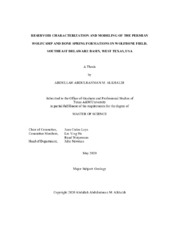| dc.description.abstract | The west of Texas and New Mexico Permian Basin is defined as a complex sedimentary system which is placed in the Marathon-Ouachita Orogenic Belt’s Foreland. It extends across 52 counties with an area of 75,000 square miles with a width of approximately 250 miles and a length of 300 miles composed of more than 7,000 fields. Furthermore, the hydrocarbon generation started about 100 years ago in the Permian Basin. The U.S. Energy Information Administration stated that the Basin’s contribution to the entire U.S. hydrocarbon production was around 18% in 2013 and approximately 20% in 2017 including almost 9% of the entire U.S. dry gas production. Though, the study area is located southeast of Delaware Basin within the Giant Permian Basin, at Pecos County, Texas, USA. The subsurface data were taken from seven vertical wells that cover an area of almost 40 square miles targeting Bone Spring and Wolfcamp Formations. The intention of this research is to focus on the Delaware Basin, one of the Permian Basin’s sub basins, by delivering a 3D geological model that illustrates an implementation of a field development strategy on both Unconventional Wolfcamp and Bone Spring Formations. The steps include interpreting the subsurface petrophysical and geomechanical data to identify sweet spots for the landing of horizontal wells as well as estimating the hydrocarbon’s volumetric in our area of interest. Nevertheless, total organic carbon content ‘TOC’ is the most important parameter in terms of determining the hydrocarbon storage in unconventional resources. Since geochemistry data analysis is not available and mineralogy and elemental analysis are also absent, the hydrocarbon in place was estimated based on water saturation and porosity. Our result shows that the Bone Spring and Wolfcamp formation have an estimated ultimate recovery ‘EUR’ of 1.5 billion barrel of oil ‘BBO’ and 500 million barrel of oil ‘MMBO’ respectively as a total resource assessment. However, cut off values have been assigned to find the best tier in the field for original oil in place ‘OOIP’ calculation. The net/gross is determined by applying suitable reservoir parameters cut offs so that uneconomic or unproductive zones are not included. These cut offs are applied to porosity above or equal to 5%, water saturation equal or less than 40 % and brittleness index greater or equal to 30%. Thus, the EUR of the best areas in the field for Bone Spring and Wolfcamp formations are calculated to be around 786 million barrel of oil ‘MMBO’ and 276 million barrel of oil ‘MMBO’, respectively. Moreover, the best landing zones of both formations were mainly associated with organic rich mudstone that shows an average porosity of greater than 10% and water saturation less than 20%. | en |


